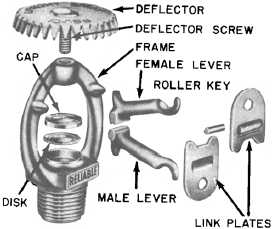be plated for appearance or they maybe coated for protection from an adverse environment. For example, sprinklers that will be used in corrosive atmospheres are either lead- or wax-coated. Finally, automatic sprinklers are normally held closed by heat-sensitive elements that press down on a cap over the sprinkler orifice and are anchored by the frame of the sprinkler. The heat-sensitive elements melt and release at different temperatures depending on application. Sprinklers are color coded to identify the temperature range rating of the fusible element (table 8-1). Color coding is not required for plated sprinklers, ceiling sprinklers, or similar decorative types.
There are basically four types of release mechanisms for automatic sprinklers. They are the fusible link, frangible bulb, frangible pellet, and bimetallic element.

Figure 8-14. - Fusible link automatic sprinkler.
The fusible link sprinkler (fig. 8-14) is kept closed by a two-piece link held together by a solder with a predetermined melting point. When the solder melts, the levers pull the two-piece link apart and fly away from the sprinkler. Pressure in the piping network pushes the cap from the orifice of the sprinkler to discharge water.
The frangible bulb sprinkler (fig. 8-15) has a small bulb made of glass between the orifice cap and the sprinkler frame. The bulb is partially filled with a liquid. Air fills the remaining space. Heat from a fire will cause the liquid to expand against the air causing the glass bulb to shatter and opening the sprinkler for water discharge.

Figure 8-15. - Frangible bulb automatic sprinkler.
Table 8-1. - Sprinkler Temperature Ratings

